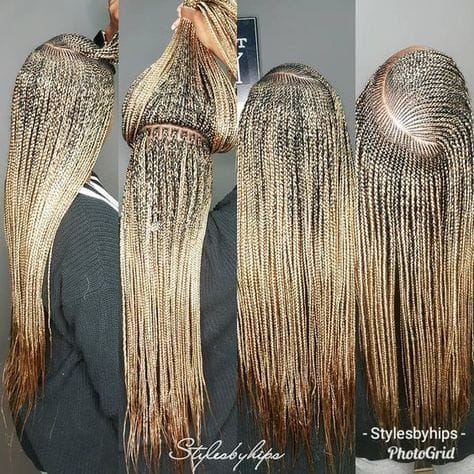Tribal braids are a popular hairstyle that features many different patterns and techniques from African cultures. They are not only beautiful and versatile, but also have a rich history and cultural significance.
History of Tribal Braids
Braiding is one of the oldest forms of hairstyling, dating back to ancient times.
Some of the most well-known tribal braiding styles are Fulani braids, Ghana braids, and box braids.
Tribal braids were also a form of art and expression, as well as a practical way to protect the hair from harsh weather and environmental conditions.
Braiding also helped to keep the hair clean and prevent lice and other parasites.
Additionally, braiding was a social activity, where women and girls would gather to braid each other’s hair and share stories and wisdom.

Caption; Pinterest
Cultural Significance
Tribal braids are more than just a hairstyle; they are a symbol of identity, heritage, and pride.
They represent the connection to the ancestors and the traditions of African cultures.
They also reflect the creativity and diversity of the African diaspora, as different braiding styles have evolved and adapted to different contexts and influences over time.
Tribal braids are often decorated with various accessories, such as beads, rings, shells, and cowries. These adornments have different meanings and purposes, depending on the culture and the occasion.
For example, beads can signify wealth, beauty, fertility, or spirituality. Cowries can represent prosperity, luck, or protection. Shells can symbolize the ocean, the source of life.
Types of Tribal Braids
Fulani braids: These are named after the Fula people of West Africa, who are known for their intricate and elaborate braiding patterns.
The signature part of the style is a central braid or twist at the crown of the head, traditionally decorated with rings and beads.
Thin to medium side braids accompany it, left loose or plaited into an updo.
Ghana braids: These are also known as banana braids, cornrows, or pencil braids.
This results in a tapered effect, where the braids start thin and get thicker towards the ends.
Ghana braids can be done in different patterns and directions, such as straight back, zigzag, or curved.
Box braids: These are one of the most popular and versatile tribal braiding styles.
Choosing the Right Tribal Braids
- Your face shape:
- Your hair type:
- Your lifestyle:
- Your personality:
Styling Tribal Braids
Accessorize: Elevate your braids with beads, rings, shells, cowries, ribbons, or clips. Mix and match for a unique look, creating patterns or highlighting features.
Experiment with color: Infuse color into tribal braids using colored extensions or dye. Match your skin tone, contrast, or complement your natural hair color. Explore ombre, balayage, or highlights.
Explore hairstyles: Transform into buns, ponytails, pigtails, half-updos, space buns, or braided crowns. Twist, curl, or crimp for texture. Secure with pins, bands, or scarves for added flair.
Caring for Tribal Braids
Maintain scalp hygiene: Mist water or diluted shampoo on your scalp, massage gently, and wipe away dirt. Apply a light oil or leave-in conditioner to prevent itching.
Careful braids washing: Wash every 1-2 weeks with diluted mild shampoo. Avoid scrubbing, gently squeeze to remove dirt, and rinse thoroughly.
Condition and seal: Apply leave-in conditioner to braids, focusing on ends. Seal with cream or butter to prevent frizz. Air-dry or use low heat.
Night protection: Wrap braids in satin or silk scarf, bonnet, or use a pillowcase to prevent friction and maintain smoothness.

















